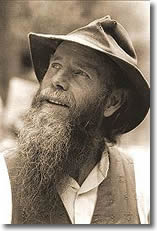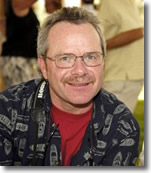Lectures 2000
January 28Spring in the Andes
by Charles Dailey, Sierra College
Where does Spring arrive in the month of November? In the southern hemisphere! While we slip into our California winter, the southern hemisphere blooms gloriously and its wildlife responds. Join Sierra College biologist Charles Dailey for a slide-illustrated lecture on his recent trip down the length of Argentina. This incredible place on Earth can boast of rheas, penguins, condors, and whales as well as towering Andean mountains clad with icy glaciers.
This Dailey expedition covers the South American equivalent of a span from Baja California to the panhandle of Alaska in North America. This enormous region of mountains, floodplains, pampas and deserts terminates in the famous Tierra del Fuego, the southern tip of the Americas. Join us for a memorable photographic review of the geology, biology and history of the southeast side of South America.
February 25The Ten Worst Storms of the Century
by Jim Goodridge, California State Climatologist (retired), American Meteorological Society
The museum is delighted to host a meeting of the American Meteorological Society (Sacramento Chapter) as an introduction of this organization to our museum family. retired State Climatologist Jim Goodridge will describe California's ten worst storms of the past century. Additionally, he will discuss recent research and developments in the interpretations and understanding of sunspots as they relate to long-term climatology. Introducing Jim will be current AMS president Laura Ashley, formerly Chief Meteorologist for Channel 10. Also present will be Elizabeth Morse, Meteorologist in Charge for the National Weather Service in Sacramento.
March 24Winged Predators
by Brain T. Farrell
Using live birds of prey to awaken environmental curiosity and concern, Brian Farrell will put on a flying demonstration in the spacious Dietrich Theater using three North American birds of prey. Brian, who is a licensed Master Falconer, teaches at Silverado Middle School in Roseville but also "hits the road" between year-around school sessions to share his appreciation and concern for America's birds of prey. Using a Gyrfalcon (the world's largest falcon from the Arctic and the most prized bird in falconry), a Ferruginous Hawk (the world's largest hawk), and a Harris Hawk (once extinct in California, but slowly making a comeback), Brian will discuss and fly these magnificent birds. Included in his presentation will be ecological information of common and endangered species,the importance of viable habitat and a history of falconry. Don't miss this spectacular show!
April 28The Spirit of John Muir
by Lee Stetson as John Muir
 Back for his seventh seasonal performance at Sierra College, famed Yosemite actor Lee Stetson will perform "The Spirit of John Muir", one of his self-written plays reflecting upon the life of John Muir. Each year, Stetson's performance differs from that of the previous year. In this performance, Muir himself, once again roaming the wilderness of his beloved Yosemite Valley, comes alive with the vivid images of these astonishing adventures, all true, and related largely in his own works.
Back for his seventh seasonal performance at Sierra College, famed Yosemite actor Lee Stetson will perform "The Spirit of John Muir", one of his self-written plays reflecting upon the life of John Muir. Each year, Stetson's performance differs from that of the previous year. In this performance, Muir himself, once again roaming the wilderness of his beloved Yosemite Valley, comes alive with the vivid images of these astonishing adventures, all true, and related largely in his own works.
One moment you'll be riding with Muir on a snow avalanche 3,000 feet down one of the Yosemite Valley walls, next climbing up a 500 foot ice cone at the base of upper Yosemite Fall, then rocking and reeling on a new-born talus slope during a stupendous earthquake. These, along with other joyful encounters with the Yosemite wilderness are among many exciting and witty stories, all of which led Muir to his spirited defense of wild lands and wild creatures. Don't miss this heart-warming performance in celebration of Earth Day 2000.
May 19Ethnobotany: Traditional Uses of Native Plants
by Renee Shahrokh
California's natural resources of plants, animals and minerals provided almost unlimited materials for utilization by its native peoples. For this reason, and for its climate as well, some of the densest concentrations of Native Americans found California an ideal place to live. Ethnobotanist Renee Shahrokh will discuss the traditional uses of native plants by tribes of Central California. Species utilized for food, medicine and material culture will be discussed. How were these plants gathered? How were they processed? Edibles, such as fruits, bulbs, algae and even poisonous plants will be reviewed.
Renee Shahrokh is a botany professor at American River College where she teaches ethnobotany, botany and plant identification.She has also taught ethnobotany for D.Q. University in Davis and for the Miwok Archaeological Preserve at Point Reyes.
September 22Siberian Natural History
by Elena Pravosudova, Ph.D.
 Siberia is an enormous place. Situated in arctic and subarctic Asia it includes a wide variety of ecological habitats including, but not limited to, tundra. This vast region of boundless biological treasures lured scientists Elena Pravosudova and her husband whose interests were primarily ornithological. Between 1985 and 1991, Elena worked for the Russian Academy of Science.
Siberia is an enormous place. Situated in arctic and subarctic Asia it includes a wide variety of ecological habitats including, but not limited to, tundra. This vast region of boundless biological treasures lured scientists Elena Pravosudova and her husband whose interests were primarily ornithological. Between 1985 and 1991, Elena worked for the Russian Academy of Science.
She and her husband lived in Northeastern Siberia and spent several field seasons studying breeding biology of both resident and migratory songbirds. Their research focused on a reparian woodland in the Magadan region, near the coast of the Okhotsk Sea. For four to six months each year they lived im a tiny cabin in the woods while conducting their research. Elena's slide-illustrated presentation will include images and discussions of natural history, ecology, and conservation issues involving this rich region of Siberia.
October 27Made for Each Other A Symbiosis of Birds and Pines
by Ronald Lanner, Ph.D.
Some trees and birds are made for each other. Take, for example, the Whitebark Pine and the Clark's Nutcracker of the Sierra Nevada. These dwellers of the high mountains provide for each other's posterity, which leads biologists to label their relationship symbiotic, or mutualistic. Ronald Lanner, Professor Emeritus of Forest Resources at Utah State University, now lives in Placerville, California.
In his slide-illustrated presentation, he details the fascinating relationship between wingless-seeded pine trees and seed-dispersing members of the crow family (especially nutcrackers and jays). His research shows how mutualism can drive not only each others' evolution, but can also affect the ecology of many other members of the surrounding ecosystem as well. Examples will focus on the Rocky Mountains and the American Southwest, but will range as far afield as the Alps, Finland, Siberia, and China—all examples of the phenomenon of co-evolution. Dr. Lanner is the author of the books Made for Each Other (Oxford Press, 1996) and, more recently, Conifers of California (Cachuma Press, 1999). Books will be available for purchase and signing.
November 3Reign of the Sierra Storm King: Human and Societal Impact of Historic Weather Events in California and Nevada
by Mark McLaughlin
 Far West droughts are often broken by flooding rain and heavy snowfall. Extreme weather events are the climatological signature of our regional habitat. Residents of the Sierra Nevada endure some of the most brutal winter storms in the world. Snowfall measured in feet, wind gusts in excess of 180 mph, destructive avalanches and wind chills far below zero conspire to wreak havoc on anyone caught unprepared. Over the years many people have paid with their lives while attempting to pass through the wintry domain of the Sierra Storm King. This lecture presents compelling stories with a graphic slide presentation that brings thes amazing events to life.
Far West droughts are often broken by flooding rain and heavy snowfall. Extreme weather events are the climatological signature of our regional habitat. Residents of the Sierra Nevada endure some of the most brutal winter storms in the world. Snowfall measured in feet, wind gusts in excess of 180 mph, destructive avalanches and wind chills far below zero conspire to wreak havoc on anyone caught unprepared. Over the years many people have paid with their lives while attempting to pass through the wintry domain of the Sierra Storm King. This lecture presents compelling stories with a graphic slide presentation that brings thes amazing events to life.
Mark McLauglin is a weather historian, newspaper columnist, and author living at Lake Tahoe. This Evening's presentation is brought to the museum by the Sacramento Chapter of the American Meteorological Society.
December 8Placer County is for the Birds
by Brian Williams
More than 300 species of birds call Placer County home; at least for part of the year. Many are residents, some migrate vertically (in altitude), others migrate laterally; some for thousands of miles. The birds are here for numerous reasons: food, shelter, favorable nesting conditions, or even for a short rest during a longer migration. One thing for certain, birds are an important component of this county's rich biological diversity. Placer's bird diversity responds to its varied habitats—from valley grasslands and marshlands to chaparral to the broadleaf and conifer forests that spread from the foothills to Lake Tahoe.
Brian Williams is a professional environmental consultant who has taught ornithology at Sierra College for many years. His slide-illustrated presentation will include a suite of "typical" Placer birds, but will focus on a selected group of birds under the watchful eye of ecologists who know that birds are valuable "environmental barometers" or harbingers of change. Population trends of species like Burrowing Owl, Great Egret, California Quail, and Western Meadowlark will be discussed as important indicator species. Others will surprise us in that they have been spotted in our area: Harlequin Duck, Black Rail, and Arctic Tern.
